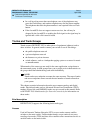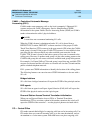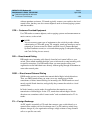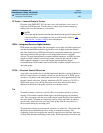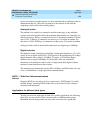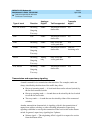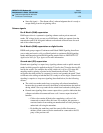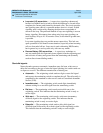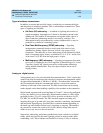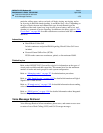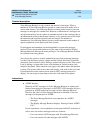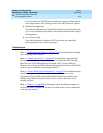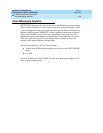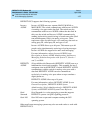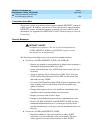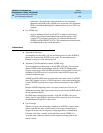
DEFINITY ECS Release 8.2
Administrator’s Guide
555-233-506
Issue 1
April 2000
Features and technical reference
1572Trunks and Trunk Groups
20
Types of address transmission
In addition to seizure and start dial signals, switches have to transmit the digits
and characters for telephone numbers. This is called address transmission. Three
types of signaling are available:
■ Dial Pulse (DP) addressing — A method of signaling that consists of
regular momentary interruptions of a direct or alternating current at the
sending end. The number of interruptions corresponds to the value of a
digit or character (alternating current is not used by switches). The
interruptions usually are produced by a rotary telephone dial, or may be
produced by a sender in a switching system.
■ Dual Tone Multifrequency (DTMF) addressing — Signaling
arrangements (commonly known as touch-tone) that consist of two,
simultaneous, dialing signals. One tone is from a low group of four
frequencies. The other tone is from a high group of four frequencies. Both
tones correspond to digits, letters, or characters (0–9, A–Y, or * and #). One
of the tones (1,633 Hz) from the high group is a spare.
■ Multifrequency (MF) addressing — Signaling arrangements that make
use of only 2 frequencies out of 6 to represent 10 decimal digits (0– 9) and
5 auxiliary signals. MF signals are used for called number addressing,
calling number identification. They also report whether the far end is
ringing or busy.
Analog vs. digital trunks
Analog trunks carry voice and voiceband data communication. “Voice” means that
sound of any kind is transformed into electrical waveforms and transmitted within
an approximate bandwidth of 300 Hz to 3,400 Hz. “Voiceband data” means that
data is transmitted within the voiceband and requires a conversion resource
(modem) at both ends of the connection. The data-transmission rate for analog
trunks depends on the data-handling capability of the modems in the connection.
Digital trunks represent both sound and data as 0’s and 1’s and can be configured
to carry any kind of voice or data traffic. Digital trunks connect to a DS1 circuit
pack and provide a T1 or E1 carrier. DS1 service provides an interface for CO,
FX, DID, tie, and WATS trunks. The DS1 interface supports incoming and
outgoing dial types of ground-start, loop-start, auto/auto, auto/delay, auto/immed,
and auto/wink. Signaling may be robbed-bit or common-channel depending on
the trunk type and whether the dial-type is incoming or outgoing. The interface
may be used to connect the switch to a toll office directly using wink-start tie
trunks for two-way access to the toll network.
Supervision, addressing, and alerting methods have been carried over to digital
trunks, which use basically the same signaling scheme as analog trunks when
establishing a call. These schemes are handled in a variety of ways to indicate



